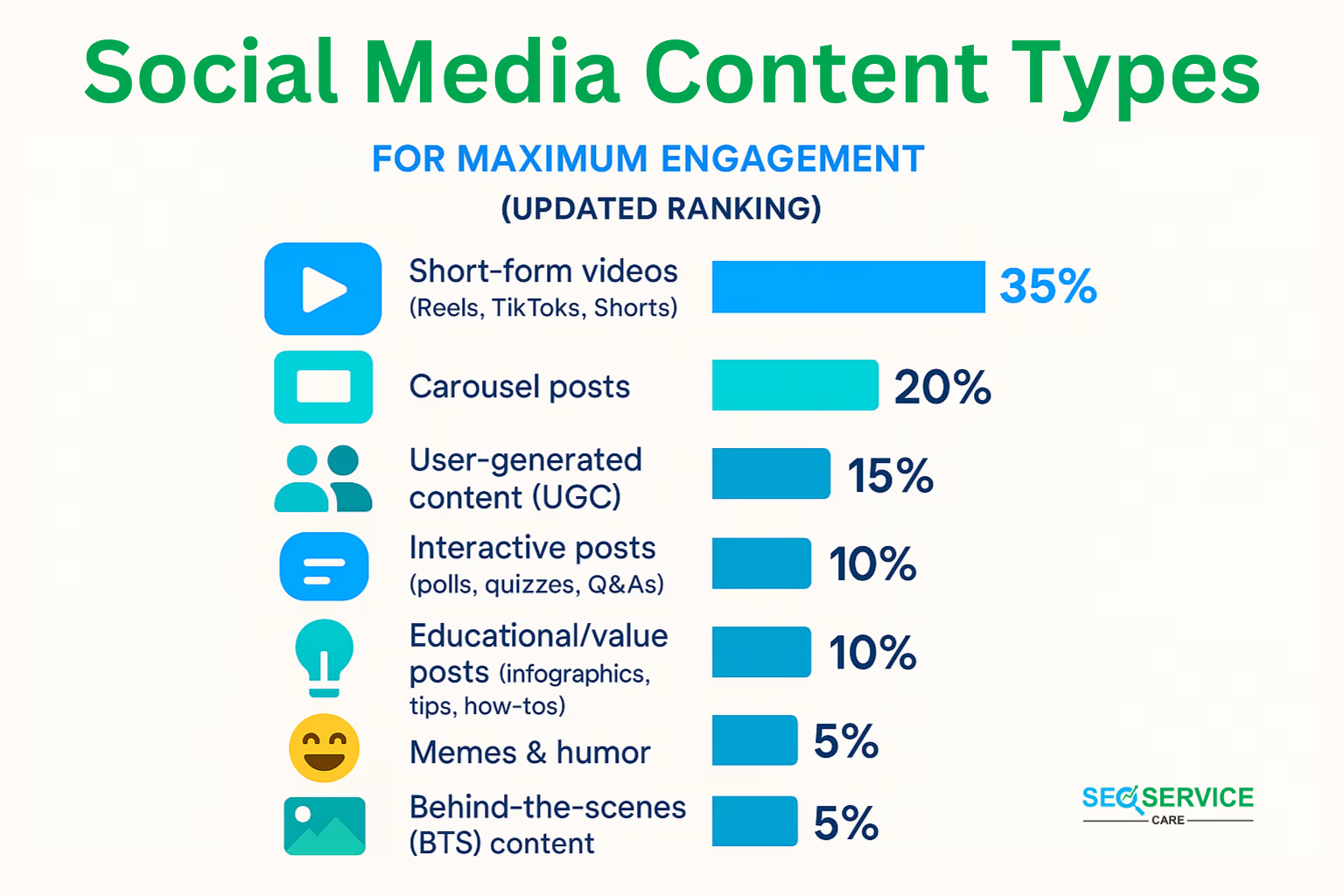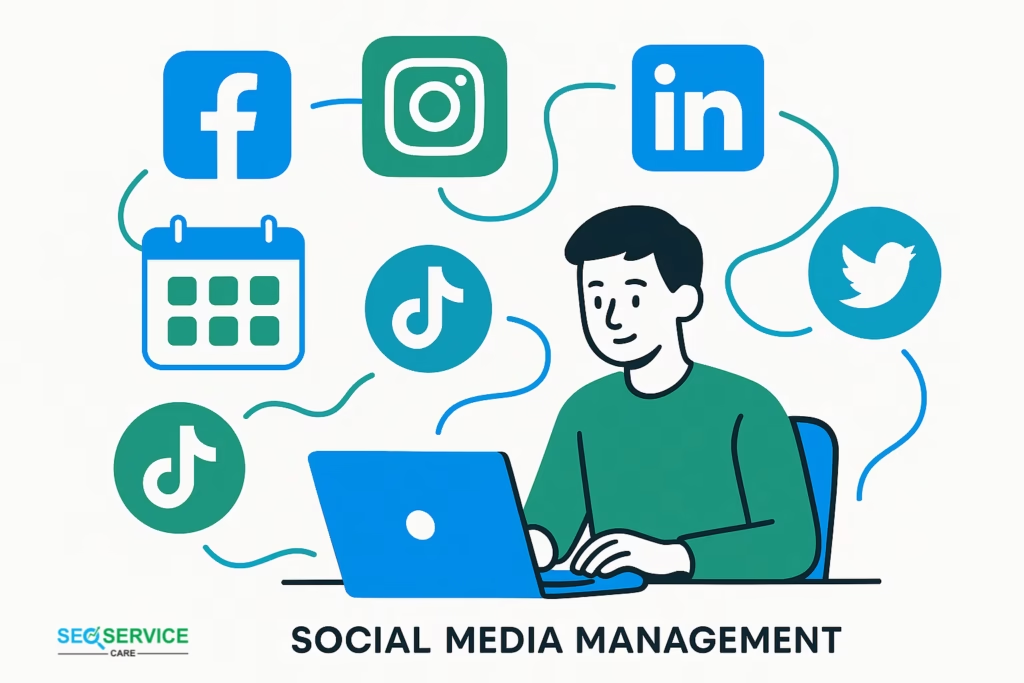Welcome to the Social Media Management Guide 2025, your step-by-step roadmap to building a strong online presence.
Social media is no longer just a place for sharing photos with friends. It has become a powerful tool for businesses, professionals, and creators. If you are running a small shop, a startup, or building a personal brand, effective social media management is extremely essential for your growth.
That’s why you need a clear, beginner-friendly strategy. If you’re just new to marketing or a small business owner, this guide will help you master the basics and manage your social media like a pro.
What is Social Media Management?
Social Media Management (SMM) is the smart handling of your brand or business on social platforms (like Fb, Instagram, LinkedIn, TikTok) planning → creating content → publishing → engaging → measuring → improving – managing this entire cycle effectively. It also includes converting your audience with ideal customers, running ads, and monitoring trends to stay ahead of competitors.
For beginners, social media management might sound overwhelming, but with the right strategy, it becomes simple and effective. Think of it as three main steps:
- Create Content → Posts, stories, videos, and graphics.
- Engage with Audience → Replying to comments, messages, and building trust.
- Analyze Results → Checking performance, improving strategy, and repeating.
What does social media management include?
-
Planning and organizing content.
-
Publishing posts at the right time.
-
Engaging with followers through comments and messages.
-
Tracking performance through reports and analytics.
-
Running advertising campaigns.
Whether you call it social media handling, managing social media content, or social media managing, the goal is the same: connect with people and grow your brand.
Why Social Media Management is Important in 2025
Research by experts shows over 5 billion active social media users worldwide. That means nearly two-thirds of the global population is on at least one platform. Businesses can’t afford to ignore this.
According to Search Engine Journal, brands with strong social media engagement see 20–40% higher conversion rates compared to those with little to no presence. Why? Because people trust businesses that interact with them. A well-planned social media management strategy builds credibility, fosters community, and drives traffic to websites.
This also ties directly into other digital channels like SEO, email marketing, and reputation management making it a key piece of any digital marketing plan. So managing social media properly is more important than ever because customer expectations are higher, competition is stronger, and algorithms are smarter.
Here are explanation of the main reasons why social media management matters:
1. Builds Brand Awareness
People can’t buy from you if they don’t know you exist. Social media is the fastest way to put your brand in front of thousands (or even millions) of people. A consistent posting strategy makes your business recognizable.
2. Drives Website Traffic & Sales
Every post, story, or video can guide followers to your website, blog, or online store. With the right call-to-action (CTA), social media becomes a direct path to sales.
3. Strengthens Customer Relationships
Unlike traditional marketing, social media allows two-way communication. You can answer questions, solve problems, and create loyal customers who recommend your brand to others.
4. Cost-Effective Marketing
Compared to TV, print, or billboards, social media is budget-friendly. Even with a small budget, you can run ads and reach highly targeted audiences.
5. Builds Authority & Trust
Sharing expert tips, behind-the-scenes updates, and customer testimonials shows that your brand is credible and trustworthy—something people look for before making a purchase decision.
6. Helps You Stay Ahead of Competitors
Nowadays, every serious business is on social media. If you’re not managing your presence well, you risk losing customers to competitors who are more active and engaging.
Note: Social media management is no longer optional. It’s a must for businesses and individuals who want to grow, sell, and stay relevant in 2025.
That is to say, Social media marketing management helps your brand get noticed, connect with the right audience, and grow online making it essential for success.
Social Media Management Strategies That Work
Not all strategies are created equal. In 2025, the most effective ones are simple and user-focused.
-
Set SMART goals (Specific, Measurable, Achievable, Relevant, Time-bound).
-
Pick the right platforms—not every business needs to be everywhere.
-
Create a content calendar so you stay consistent.
-
Mix organic + paid campaigns for the best reach.
Knowing how to manage social media starts with understanding your audience. Without that, even the best content falls flat.
The Social Media Management Process Explained
Every great social media presence follows a clear process. Here’s what it looks like:
#1: Planning & Strategy
Decide what you want to achieve brand awareness, sales, or community engagement.
#2: Content Creation & Curation
Design visuals, write captions, and select trending topics that matter to your audience.
#3: Publishing & Scheduling
Post consistently at times when your audience is most active.
#4: Monitoring & Engagement
Reply to comments, answer messages, and keep conversations going.
#5: Reporting & Optimization
Use data to learn what works, what doesn’t, and adjust your social media management strategy accordingly.
This ongoing cycle is the backbone of any strong social media management guide.
How to Pick the Best Social Media Platforms for Your Brand
Not all social media platforms are created equal. And you don’t need to be everywhere. The key is to choose platforms where your audience is most active, your content fits best, and your resources allow consistent posting.
Here’s an overview of the major platforms for businesses in the USA:
1. Facebook
- Best for: Local businesses, service-based companies, and communities.
- Strengths: Large, diverse audience; robust ad targeting; groups and events.
2. Instagram
- Best for: Visual brands, lifestyle products, e-commerce, fashion, and food.
- Strengths: Reels and stories for high engagement; shopping features for e-commerce.
3. LinkedIn
- Best for: B2B companies, professional services, SaaS, consulting, and hiring.
- Strengths: Networking, thought leadership, case studies, professional credibility.
4. X (Twitter)
- Best for: News, tech, trends, real-time updates, thought leadership.
- Strengths: Fast-moving content; engagement with industry conversations.
5. TikTok
- Best for: Short-form video content, younger audiences, educational and entertaining content.
- Strengths: High organic reach; viral potential.
6. YouTube
- Best for: Tutorials, reviews, educational content, long-form storytelling.
- Strengths: SEO-friendly; evergreen content; monetization options.
7. Pinterest
- Best for: DIY, inspiration, design, and e-commerce traffic.
- Strengths: Highly visual; drives referral traffic to websites.
8. WhatsApp / Telegram
- Best for: Community building, customer support, and direct updates.
- Strengths: Private communication; high open rates.
How to Decide Which Platform to Focus On
Ask yourself these four questions:
- Audience: Where does my target audience spend most of their time?
- Content Fit: Can I create content that performs well here (video, visuals, text)?
- Goal Alignment: Does this platform help achieve awareness, leads, or sales?
- Resources: Can I consistently manage and post on this platform?
Quick Platform Combo Examples for USA Businesses
- Local Bakery: Facebook (menu/offers) + Instagram (Reels/stories) + WhatsApp (orders/customer care)
- SaaS Tool: LinkedIn (case studies) + YouTube (demo/tutorials) + X (thought leadership)
- Online Boutique: Instagram (Reels/UGC) + TikTok (trends) + Pinterest (shoppable pins)
Action Checklist – Platform Selection
- Evaluate platforms using audience, content fit, goals, and resources.
- Choose 1–2 primary platforms to focus on.
- Create profiles with consistent branding (bio, profile image, CTA).
- Outline 3–5 content pillars for each platform.
- Draft 10–15 initial content ideas.
Tip: Start small, master your chosen platforms, then expand. Consistency beats quantity every time.
Creating an Effective Social Media Strategy & Content Plan
Having a social media account isn’t enough, you need a strategy and a plan. A solid plan ensures your content reaches the right people, drives engagement, and grows your business.

Step 1: Define Your Goals
Before creating content, clarify what you want to achieve:
- Brand Awareness: Make people aware of your business.
- Engagement: Build relationships with your audience.
- Website Traffic: Drive visitors to your site or landing pages.
- Leads & Conversions: Turn followers into customers.
Use SMART goals (Specific, Measurable, Achievable, Relevant, Time-bound) to make your objectives clear.
Example:
“Increase Instagram followers by 1,000 in 3 months while achieving a 4% engagement rate.”
Step 2: Identify Your Content Pillars
Content pillars are the main themes your social media posts will focus on. For beginners, 3–5 pillars work best.
Example for USA Businesses:
- Educational Content: Tips, how-to guides, industry insights.
- Promotional Content: Offers, products, services.
- Social Proof: Customer testimonials, case studies, reviews.
- Behind-the-Scenes: Office, team, or product creation.
- Engagement Content: Polls, questions, challenges.
Step 3: Plan Your Content Types
Each platform favors specific content types.
- Instagram: Reels, carousels, stories, static posts
- Facebook: Feed posts, videos, groups, live sessions
- LinkedIn: Articles, carousels, professional posts
- TikTok: Short-form videos (15–60 seconds)
- YouTube: Tutorials, reviews, longer videos
- Pinterest: Pins, idea boards, product images
Step 4: Create a Posting Schedule
Consistency is key. Decide how often to post on each platform.
Example for Beginners:
- Instagram: 3 posts + 2 reels per week
- Facebook: 3 posts per week
- LinkedIn: 2 posts per week
Use scheduling tools like Buffer, Hootsuite, Later, or Meta Business Suite to save time and maintain consistency.
Step 5: Write Captivating Captions & Use Hashtags
- Captions should hook readers in the first 2–3 lines.
- Include 1–2 CTAs: “Click the link,” “Comment below,” or “Learn more.”
- Use platform-appropriate hashtags for discovery:
Instagram Example: #SocialMediaMarketing #BeginnerGuide #SmallBusinessUSA
Tip: Don’t overload hashtags, use 5–10 relevant ones per post.
Step 6: Plan Engagement
Posting alone isn’t enough. Your audience expects responses:
- Reply to comments within 24 hours.
- Answer direct messages professionally and promptly.
- Engage with other accounts in your niche (like, comment, share).
Engagement builds trust, improves algorithmic reach, and strengthens brand loyalty.
Step 7: Measure & Adjust
Track your performance regularly:
- Key Metrics: Reach, Impressions, Engagement Rate, Clicks, Conversions
- Tools: Meta Insights, LinkedIn Analytics, TikTok Analytics, Google Analytics
- Tip: Review weekly and adjust your content strategy for better results.
Action Checklist
- Set SMART goals for each platform.
- Choose 3–5 content pillars.
- Decide post types for each platform.
- Create a consistent posting schedule.
- Write captions with CTAs and relevant hashtags.
- Engage with followers daily.
- Track performance and optimize strategy weekly.
Pro Tip: Focus on quality over quantity. One high-value post can outperform five low-effort posts.
Tools for Social Media Handling in 2025
You don’t have to manage everything manually. Tools make life easier.
-
Scheduling Tools: Buffer, Hootsuite, Sprout Social, Only Social.
-
Design Tools: Canva, Adobe Express.
-
Analytics Tools: Google Analytics, native platform insights.
-
AI Tools: ChatGPT, Jasper, Copy.ai for captions and ideas. Ideogram, Sora for Image or Video.
These help simplify social media handling and free up time for strategy.
Common Mistakes in Social Media Managing
Even experienced marketers can stumble when managing social media. Recognizing common mistakes is the first step to improving your strategy.
1. Posting Without a Clear Plan
Random posting may fill your feed, but it rarely drives results. A social media management strategy ensures that every post has a purpose: to educate, entertain, or promote.
2. Ignoring Followers’ Comments or Messages
Engagement is a two-way street. Ignoring your audience can harm your brand reputation. Responding promptly builds trust, encourages conversation, and strengthens relationships.
3. Using Only Promotional Content
Too much promotion can turn followers away. The 5-3-2 and 70/20/10 rules highlight the importance of mixing informative, curated, and personal content with occasional promotional posts.
4. Not Analyzing Results
Without tracking metrics, you won’t know what’s working. Using analytics tools to monitor reach, engagement, clicks, and conversions helps you optimize campaigns and make data-driven decisions.
5. Inconsistent Posting or Branding
Inconsistency in posting frequency or visual style confuses followers. A content calendar and brand guidelines ensure your social media presence remains cohesive and reliable.
→ Avoiding these mistakes can make your social media management efforts far more effective, increase audience engagement, and deliver better ROI for both organic and paid campaigns.
Social Media Advertising Management
Organic reach is shrinking. That’s why social media advertising management is now a must. Paid ads allow precise targeting, higher visibility, and faster results. But they require careful planning. A good mix of organic engagement and paid campaigns delivers the best ROI.
However, running ads isn’t just about spending money. Careful planning is key. You need to define your goals, select the right platforms, create compelling ad creatives, set a budget, and track performance through metrics like clicks, conversions, and engagement.
A successful strategy combines organic content and paid campaigns. Organic posts build trust and community, while paid ads amplify your reach and drive measurable results. This combination maximizes ROI while keeping your audience engaged.
Social media advertising also affects brand perception. Well-crafted ads enhance credibility and can support broader strategies like Reputation Management Services or Technical SEO Services, since people often judge a brand by its online presence.
In short, mastering social media advertising management means knowing who to target, what content to promote, how to measure success and tracking results to enhance your overall strategy.
Future of Social Media Management
Where is social media headed in 2025 and beyond?
-
AI-driven automation will make scheduling and reporting faster.
-
Short-form video (TikTok, Instagram Reels, YouTube Shorts) will dominate.
-
Social commerce will blend shopping and social media into one.
-
Personalization & privacy will shape how brands handle data.
The future is clear: social media managing will be smarter, faster, and more data-driven.
Choosing Between DIY vs Hiring a Social Media Agency
Should you handle it yourself or hire experts?
DIY Pros: Cost-effective, full control.
DIY Cons: Time-consuming, lack of expertise.
Agency Pros: Access to experts, proven strategies, advanced tools.
Agency Cons: Monthly costs.
For businesses serious about growth, partnering with an agency like SEO Service Care can save time and deliver better results. This ties in with White Label SEO Services and Social Media Marketing Services for a complete digital approach.
FAQs
Q1: How much time should beginners spend on social media management?
About 5–10 hours per week for content creation, posting, and engagement.
Q2: What is the difference between social media management and social media marketing?
Social media management focuses on planning, creating, scheduling, and analyzing content, while social media marketing includes advertising, influencer collaborations, and other paid promotional strategies.
Q3: How often should I post on social media?
It depends on the platform and audience. For example:
-
Facebook/Instagram: 3–5 times per week
-
LinkedIn: 2–3 times per week
-
X (Twitter): 1–3 times per day
Consistency matters more than frequency.
Q4: How do I measure the success of my social media campaigns?
Track metrics like engagement rate, reach, click-through rate, conversions, and ROI using tools like Meta Insights, Google Analytics, or third-party platforms like Hootsuite and Sprout Social.
Q5: Can I manage social media by myself, or should I hire an expert?
You can start on your own using tools like Canva and Buffer, but hiring an expert or agency can save time and improve results, especially for strategy and ad campaigns.
Q6: How long does it take to see results from social media?
Organic growth can take 3–6 months, while paid ads can deliver faster results. Consistency and strategy are key to achieving long-term ROI.
Q7: How long does it take to see results from social media?
Organic growth can take 3–6 months, while paid ads can deliver faster results. Consistency and strategy are key to achieving long-term ROI.
Building a Winning Social Media Management Strategy
Social media management is a long-term strategy. By following this guide, you can start building a strong presence online. And if you’d like expert support to accelerate your growth, SEO Service Care is here to help. Beginners who follow this guide can:
-
Build a strong online presence
-
Engage and grow their audience
-
Drive traffic, leads, and sales
Ready to take your social media to the next level? Contact us today for a free consultation tailored for USA businesses. And know how SEO Service Care can help with Social Media Marketing, Reputation Management, Local SEO, Ecommerce SEO, Technical SEO, Email Marketing, and more.



